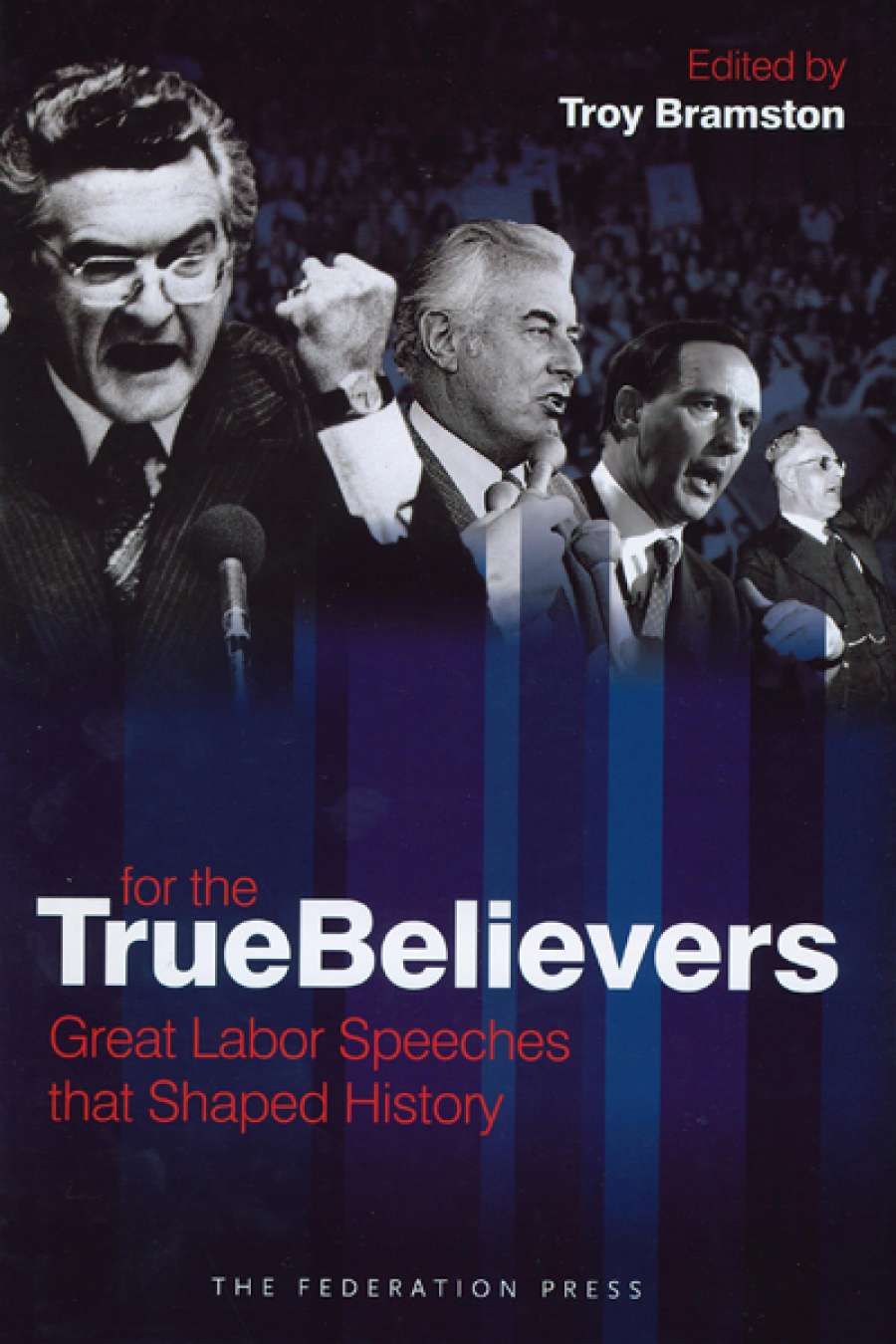
- Free Article: No
- Contents Category: Politics
- Review Article: Yes
- Online Only: No
- Custom Highlight Text:
Gough Whitlam’s famous words during his impromptu speech after the Dismissal in 1975 remain a potent symbol of the excitements and turbulence of the Whitlam era. As Troy Bramston’s collection of ALP speeches since 1891 reminds us, political speeches can capture a national mood or sentiment at a particular time in history. Indeed, a carefully crafted set of words can become a treasured part of our national self-image. They can also boost or destroy a politician’s reputation. In an age when the media has become uncritically obsessed with gaffes, Twitter banalities, polls, and sound bites, it is worth remembering that a good speech can elevate the national conversation and appeal to our better instincts.
- Book 1 Title: For the True Believers
- Book 1 Subtitle: Great Labor speeches that shaped history
- Book 1 Biblio: The Federation Press, $64.95 hb, 480 pp
The title of this book is eye-catching but inaccurate. This is a collection of speeches by Labor politicians, but the focus is less on the Labor platform than on the image of the ALP federal leader as a unifying national force. Few, if any, of these speeches can really claim to have shaped Australian history in the sense of altering, by the act of their delivery, the course of the nation. At best, compelling phrases from individual speeches influenced the way Australian historians and contemporary political reporters wrote about key national events and the changing social and political times.
The collection’s true value is to highlight those speeches where the ALP leader has made the right speech at the right time, expressing true sentiment without becoming too sentimental, appearing non-partisan while reaffirming the political legitimacy of the leader and by inference, the Australian Labor Party. Then Opposition leader Simon Crean’s speech to the troops before departing for service in Iraq in 2003 is a powerful example of this genre. In what could have been a divisive, disastrous public statement, Crean was able to skilfully advance Labor’s opposition to the war while expressing utmost admiration for the soldiers and acknowledging their circumstances:
I don’t want to mince my words because I don’t believe that you should be going … I do support our troops and always will, and that distinction is fundamentally important. The men and women of our fighting forces in a democracy are expected unquestioningly to accept the orders of the government of the day … You are a magnificent fighting and Defence Force, you have been trained for it …
The speeches are organised into several major themes, including foreign relations, war, election campaigns, and Aboriginal reconciliation. Each speech is accompanied by the editor’s well-researched descriptions of the immediate context of the speech and, sometimes, insightful comments by political speechmakers and speechwriters about the purpose and construction of the powerful phrases that have been uttered under the ALP banner. Bramston also contributes a fascinating introduction about the nature of speechwriting in the ALP context, with some interesting reflections by Labor leaders such as Bob Hawke: ‘For me, Parliament was just a charade. I just couldn’t get excited about it because it didn’t matter if you made a terrible speech or a good speech, the decisions were already made [in the government party room].’
The loose thematic structure of the book is its central weakness. A more strictly chronological approach (e.g. ‘Early Labor 1891–1914, World War I’, etc.), with regular short essays before each speech section to provide some explanation for prominent ALP policies, attitudes, and institutional structures at various times in its history would have allowed for more in-depth readings. Even the most ardent Labor history buff is likely to be confused by the kaleidoscope of past and present ALP orthodoxies and/or bugbears referred to within the text: socialism, business monopolies, free trade, protectionism, White Australia, the anti-communist Movement, the role of unions, and so on. The editor gives good context for individual speeches, but could have done more to sketch their wider historical setting.
Labor speeches, at least in this collection, often serve two gods: idealism and hard-edged pragmatism. Inevitably, the seams sometimes show on the page as the politicians try to please both the ‘true believers’ and the ‘what’s in it for me?’ crowd. It is no accident that some of the most satisfying speeches in this collection relate to military sacrifice, allowing the speechwriter to capture popular sentiment without political distractions. Paul Keating’s eulogy for the unknown Australian soldier is a well-known example of commemorative speechmaking by an ALP politician:
We do not know who loved him or whom he loved. If he had children we do not know who they are. His family is lost to us as he was lost to them. We will never know who this Australian was. Yet he has always been among those we have honoured.
A new anthology will always spark debate over what gets in and what is left out. I was surprised there were so few speeches specifically focused on the ‘quality of life’ concerns of Gough Whitlam, such as local community, regionalism, decentralisation, and urban development. Such issues were a vital part of Whitlam’s push for national reform. Nevertheless, Troy Bramston has done well to bring the art of Labor speechmaking to greater attention by the reading public. It will also be a useful reference book for those wishing to understand the evolving nature of the Australian Labor Party.


Comments powered by CComment